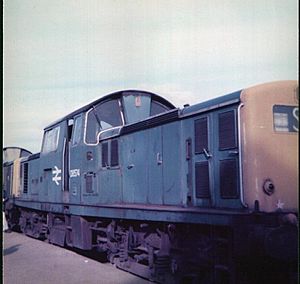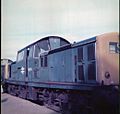British Rail Class 17 facts for kids
Quick facts for kids Clayton Type 1British Railways class 17 |
|
 |
|
| D8574 at Glasgow Works. | |
| Power type | Diesel-electric |
|---|---|
| Builder | Clayton Equipment Company & Beyer, Peacock & Co. |
| Build date | 1962–1965 |
| Total production | 117 |
| Configuration | Bo-Bo |
| UIC classification | Bo'Bo' |
| Gauge | 4 ft 8 1⁄2 in (1,435 mm) |
| Wheel diameter | 3 ft 3+1⁄2 in (1.003 m) |
| Minimum curve | 3.5 chains (70 m) |
| Wheelbase | 36 ft 6 in (11.13 m) |
| Length | 50 ft 7 in (15.42 m) |
| Width | 8 ft 9+1⁄2 in (2.68 m) |
| Height | 12 ft 8 in (3.86 m) |
| Locomotive weight | 69 long tons (70.1 t) |
| Fuel capacity | 500 imp gal (2,300 L; 600 US gal) |
| Prime mover | Paxman 6ZHXL, 2 off except D8586–8587: Rolls Royce ‘D’ type V8, 2 off |
| Generator | D8500–D8587: GEC WT800 D8588–D8616: Crompton Parkinson |
| Traction motors | GEC WT421, nose suspended, 4 off |
| Transmission | DC generator, DC traction motors |
| Multiple working | D8500–D8587 ◆ Red Diamond D8588–D8616 ★ Blue Star |
| Top speed | 60 mph (97 km/h) |
| Power output | Engine: 900 hp (671 kW) At rail: 602 hp (449 kW) |
| Tractive effort | Maximum: 40,000 lbf (178 kN) Continuous: 8,000 lbf (35.6 kN) |
| Train heating | None; through steam pipe |
| Locomotive brakeforce | 35 long tons-force (349 kN) |
| Train brakes | Vacuum |
| Career | British Railways |
| Number | D8500–D8616 |
| Axle load class | Route availability 4 |
| Retired | 1968–1971 |
| Disposition | One preserved, remainder scrapped. |
The British Rail Class 17 was a type of diesel locomotive used by British Railways. These trains were also known as the Clayton Type 1. They were built between 1962 and 1965.
These locomotives were part of a big plan to replace old steam trains with newer, more modern diesel and electric ones. The Class 17s were designed for lighter duties. This included moving freight wagons and sometimes pulling passenger trains on smaller lines.
Contents
Building the Class 17s
The Class 17 locomotives were built by two companies. Most of them were made by the Clayton Equipment Company. A few were also built by Beyer, Peacock & Co.. In total, 117 of these locomotives were produced.
Design and Features
The Class 17 had a unique look. It had a low cab in the middle of the train. This design was meant to give the driver a good view. However, it also meant the driver's position was quite cramped.
These locomotives were diesel-electric. This means they used a diesel engine to power a generator. The generator then produced electricity to drive the wheels. Most Class 17s had two Paxman engines. A couple of them used Rolls Royce engines instead.
Power and Speed
Each Class 17 locomotive had a power output of 900 horsepower. They could reach a top speed of 60 miles per hour (97 km/h). This made them suitable for the lighter tasks they were given. They were not designed for very fast express passenger services.
Why They Didn't Last Long
Even though they were new, the Class 17s did not stay in service for very long. They faced several problems.
Engine Troubles
The main issue was with their engines. The Paxman engines often had reliability problems. This meant the trains frequently broke down. They needed a lot of repairs, which was expensive and time-consuming.
Driver Comfort and Visibility
Drivers also found the low, central cab uncomfortable. It was also said that visibility was not as good as expected. This made them less popular with the train crews.
Retirement and Legacy
Because of their problems, British Rail decided to retire the Class 17s very early. Most of them were taken out of service between 1968 and 1971. This was only a few years after they were built.
Most of the 117 locomotives were scrapped. However, one Class 17 locomotive has been saved. It is now preserved and can be seen by people who love trains.
Images for kids



